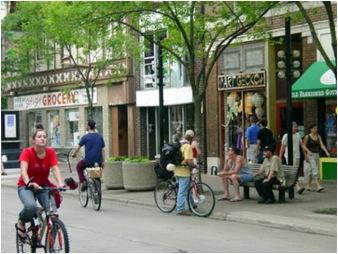
CNU Presents at ITE Annual Meeting
Urban Thoroughfares Manual is "The Right Fix" for Connecting Streets, Connecting Communities.
Submitted on 08/22/2011. Tags for this image:Last week, nearly 600 attendees gathered in St. Louis for the Institute of Transportation Engineers Annual Meeting. CNU Program Director Heather Smith attended and presented at the conference on the CNU/ITE co-authored manual Designing Walkable Urban Thoroughfares: A Context Sensitive Approach. As the below dispatch from Smith captures, excitement is building for the work behind the CNU/ITE manual. With over 1500 downloads of the manual from the ITE website, Designing Walkable Urban Thoroughfares has become a tool that transportation planners, public works departments, city leaders, and community members use to design better streets, mitigate traffic, spur economic growth, and act on public health concerns.
Read Smith's account of the conference below, and click here for the newly retooled and updated page containing the latest on how the CNU/ITE manual can deliver a “Right Fix” to communities across the country.
CNU's Heather Smith's dispatch from ITE Annual Meeting:
At the ITE meeting, there was an excitement about new methodologies and techniques for designing safer streets. From sessions on Tampa Bay's pedestrian action plan and an analysis of New York's express bus system to several sessions dedicated to bicycles, pedestrians, and drivers in the midst of a typical highway- and car-focused meeting, this year's ITE conference addressed a whole range of concerns.
The CNU and ITE urban thoroughfares manual got a lot of attention in two different sessions. One session, presented by Jim Daisa and Brain Bochner, gave a hands-on look at two new case studies – one on Lancaster Boulevard in Ft. Worth and the other on a TOD development near the Pleasant Hill Bart Station in the San Francisco Bay Area.
In another session, I presented the safety benefits of highly connected networks and how the manual can be used to implement complete streets. Speaking on a panel with John LaPlante of TY Lin and Jeffrey Riegner of Whiteman, Requardt, and Associates, we addressed complete streets and multimodal level of service. John Laplante presented several counterintuitive and often overlooked points such as:
-
Designing wider roads means more time for pedestrians to cross, which in turn means more wait times for cars.
-
Designing more wait times for pedestrians means most cars will go 45 mph on major thoroughfares and stop for 2 minutes instead of going along at 30 mph with less stopping time.
-
In scenarios with narrower streets engineers can actually increase car capacity because there is less time for pedestrians to cross the street.
-
Mid-block crossings are safer for pedestrians because there is traffic coming from 2 directions instead of 4 at intersections.
-
Installing signal countdown timers at intersections yield a 25% crash reduction rate; the new MUTCD manual is requiring these signals.
LaPlante pointed out that completes streets are a must and showed the benefits of designing speeds to Level of Service D. LaPlante also pointed out that we need better ways to measure non-motorized travel. He referred to TRB's latest Highway Capacity manual (due out in September) that contains more advanced methods of analyzing pedestrian level of service. The session generated good discussion from engineers anxious to overcome the traditional approach to highway engineering.
For all the progress being made, there is still much work to be done in the field. With sessions titled “Accommodating Pedestrians and Bicycles,” the industry still retains a focus on the vehicle. Oh, for the day when this conference and others are full of bike and pedestrian designs and when there are sessions titled “Accommodating the Automobile”!
Till that time, CNU and ITE will continue working together to find ways to design safe and comfortable streets for all.


